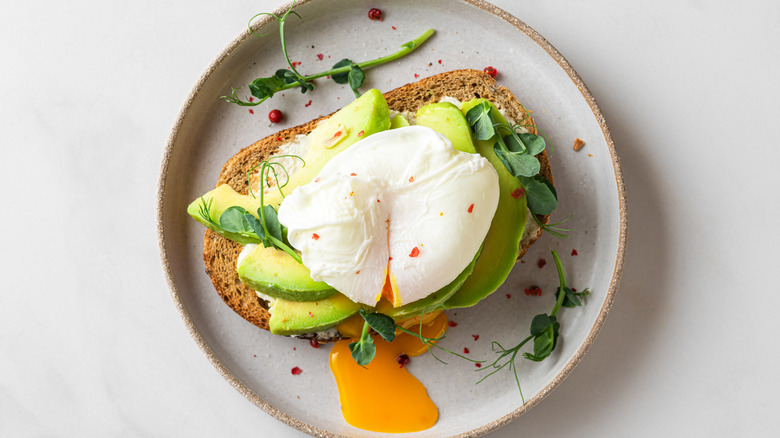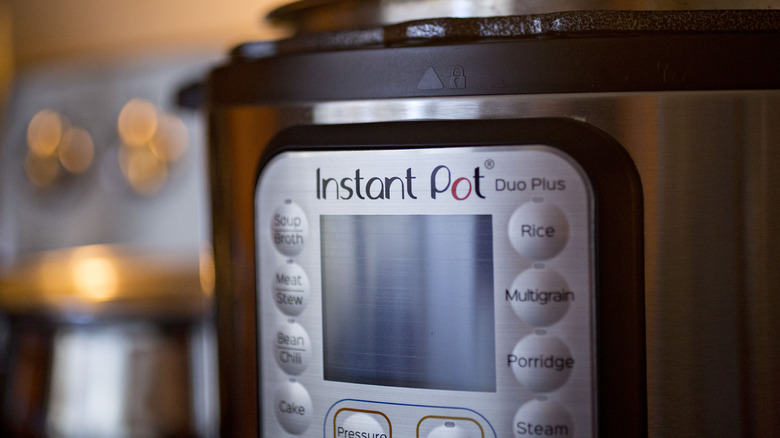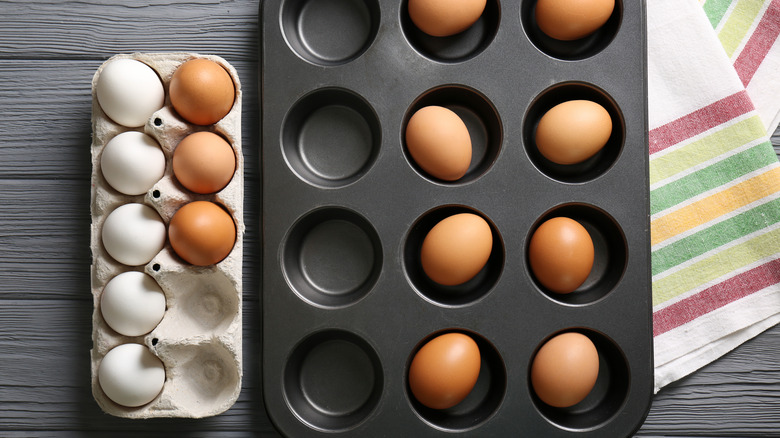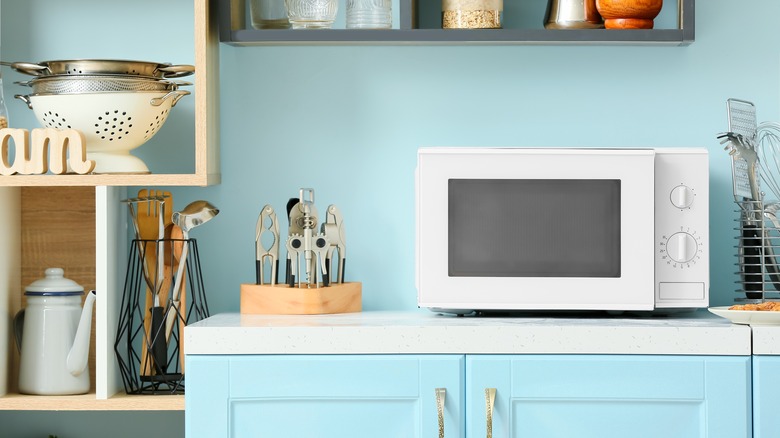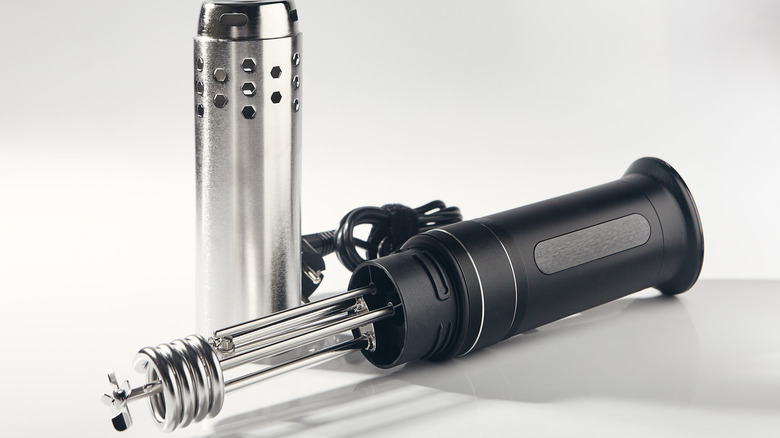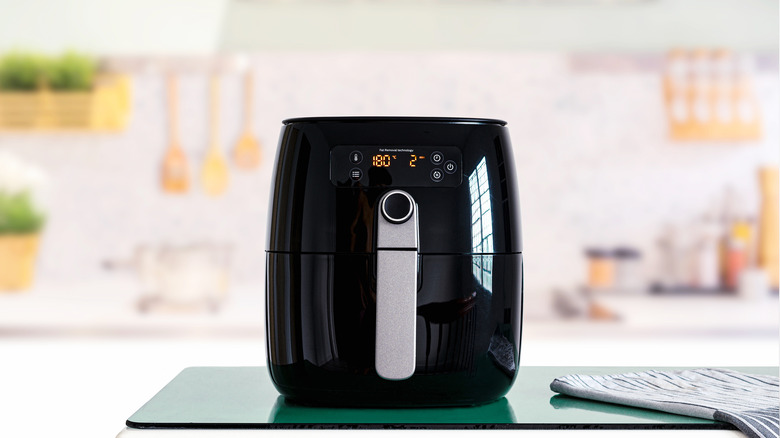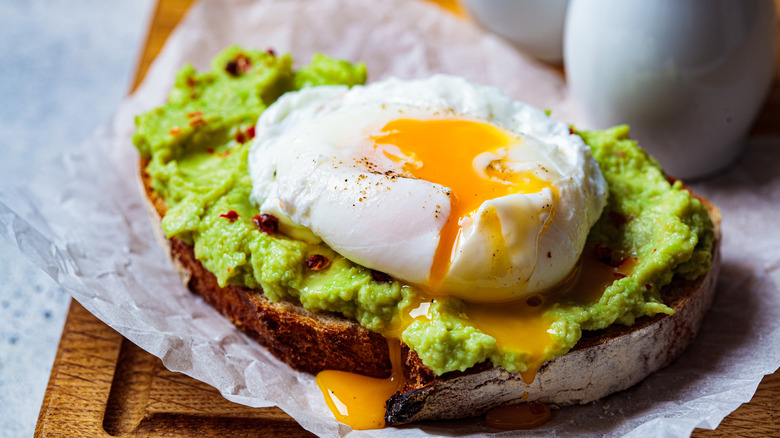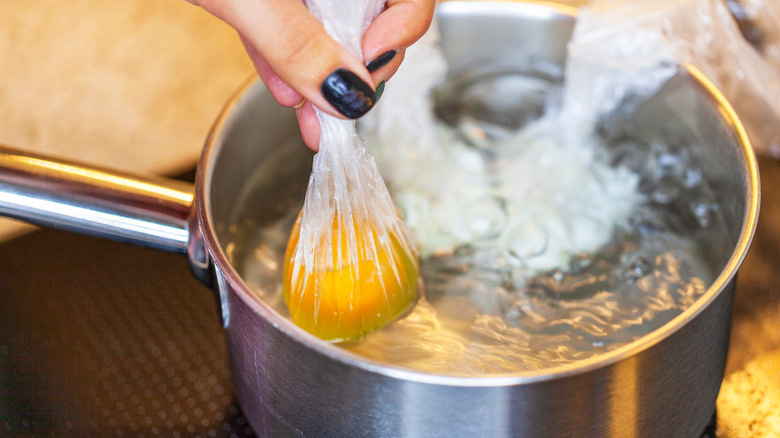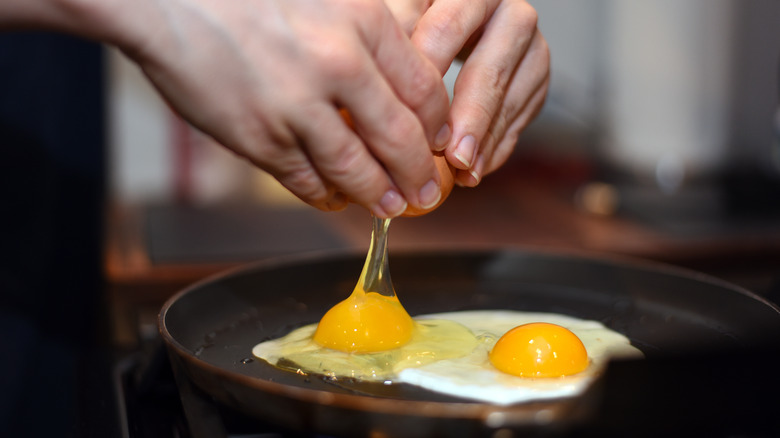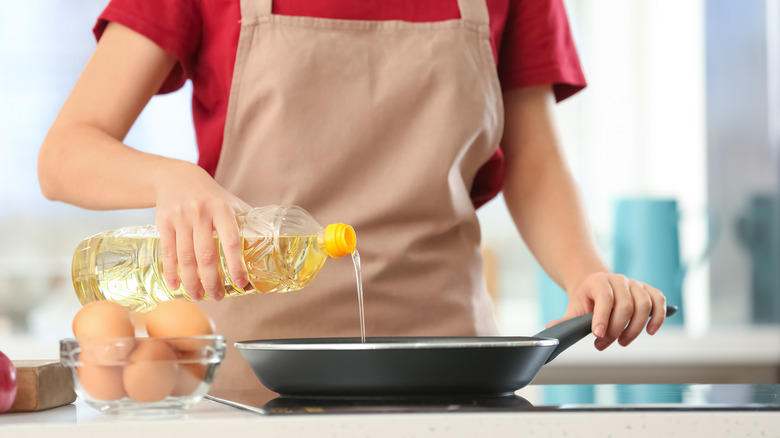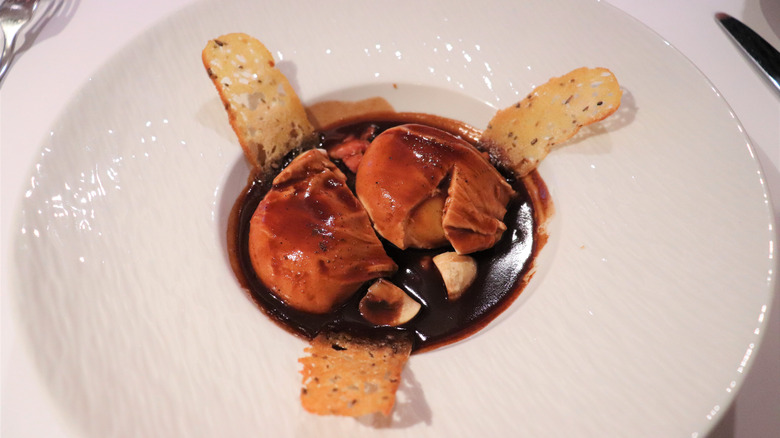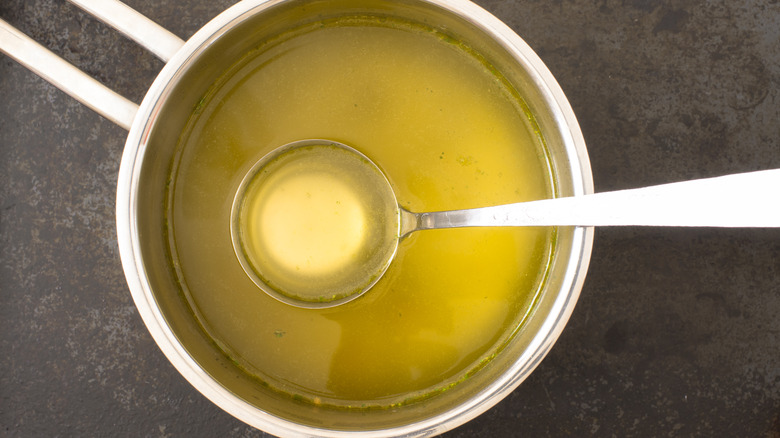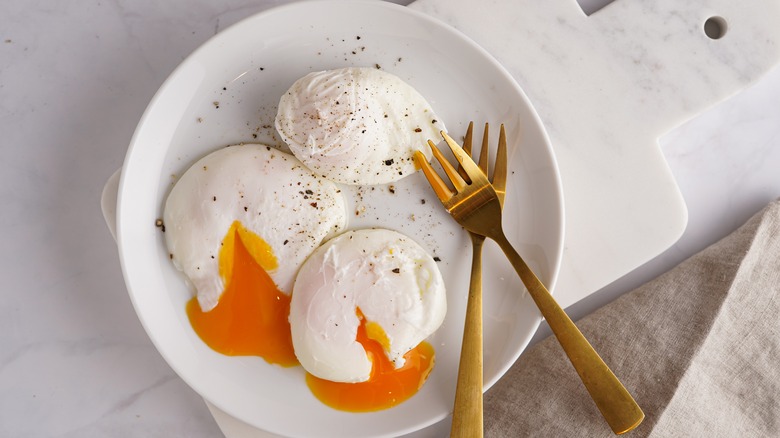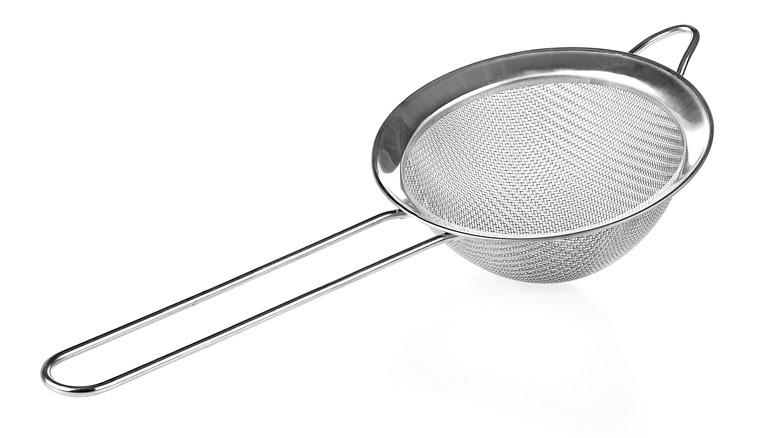13 Unconventional Ways To Poach An Egg That Actually Work
If you're a big brunch fan, then you're already familiar with the glorious breakfast food that is a poached egg. Poached eggs show up in droves on popular brunch menus — on your eggs Benedict, on salads, on sandwiches. Anywhere that a deliciously runny egg can be found, it's likely that the restaurant chooses to place a poached egg there.
However, while poached eggs might be king of the brunch menu, they're less likely something you'll enjoy at home. Poaching an egg is notoriously difficult. The water has to be just the right temperature. The eggs have to be placed in the water just the right way, or they'll fall apart. Then, you have to time the cooking process just perfectly, before gingerly removing the eggs from the simmering water. If the eggs actually make it from the water cooked and intact, then you have to worry about the possibility of jiggling or jostling the eggs too much, as you could ruin all your hard work by inadvertently puncturing the yolk before serving.
In other words, poaching an egg the old-fashioned way is not for the faint of heart. Luckily, there's more than one way to poach an egg. If you struggle with the traditional method, you might want to try one of these unconventional ways to poach an egg that actually work (or just take your typical poached egg to the next level!).
1. In an Instant Pot
If you have an Instant Pot at home, then you've likely already discovered just how versatile this kitchen countertop appliance can be. It's so much more than just a pressure cooker. Whether you want to slow cook a stew, make a big batch of rice, or just use the saute function when all your stove's burners are otherwise occupied, your Instant Pot can get the job done.
But did you know that you can also use your Instant Pot to poach eggs? Just like an Instant Pot will cook up a hunk of frozen meat in an hour flat, the Instant Pot can likewise poach an egg (or a few) in under a minute, with little work on your part. Just as the appliance lets you set and forget other dishes, so it will let you do the same when cooking this brunch favorite.
You will need a few Instant Pot accessories for this method, including the trivet that came with your Instant Pot and some heatproof ramekins. Just coat the ramekins with oil, add the eggs, and then place the egg-filled ramekins into your Instant Pot, atop the trivet. With a few cups of water in the bottom of the Instant Pot and a minute on the high-pressure setting, you'll be mere seconds away from easier-than-ever poached eggs.
2. In a muffin tin
You don't need any fancy, new kitchen countertop appliances to make poaching eggs easier. Sometimes, all you need is a little ingenuity and common bakeware that you already have around the house. That's the case, anyway, with this poached egg hack from Southern Living that simply uses your muffin tin and your oven.
The publication conducted its own experiment to see if this supposed method for making poached eggs would really work, and the good news? It did! All you have to do is add a little water and an egg to each of the muffin tin's pockets, season as desired, and then bake your eggs for just over 10 minutes. After baking, the eggs will continue cooking (thanks to residual heat) for a few minutes longer, before they're ready to serve.
Southern Living reported the muffin tin and oven-cooked poached eggs were just as runny and texture-heavy as a typical, traditional poached egg. However, unlike traditional poached eggs, the muffin tin versions were all identical in size and just the right shape for adding to a breakfast sandwich, or atop an eggs Benedict.
3. In the microwave
For those home cooks with little time and few resources at their disposal, the microwave is an invaluable tool. While some may turn up their nose at using the microwave regularly, there's no denying all that it can do for the busy cook, from defrosting frozen foods to melting chocolate. However, the microwave can also pull its weight at breakfast time, by microwave-poaching your eggs while you keep your eyes on the bacon or biscuits.
According to Real Simple, for this poached egg hack, you'll need a mug and your egg. All you have to do is add water to the mug, crack the egg into the water, and microwave the combo for about a minute. Voila — poached egg, ready for noshing.
There is one key step to poaching eggs in the microwave, though, that you won't want to forget. Always poke a very tiny hole in the egg yolk before cooking — not large enough that the yolk bursts completely, but just enough that the yolk doesn't explode during the cooking process. Otherwise, you'll end up with one messy microwave.
4. Sous-vide style
Did you jump on the sous-vide trend? If you have a sous vide immersion circulator at home, then you can use it to create the perfect, warm, circulating water bath that's typically required when poaching eggs the old-fashioned way. This time, though, the sous vide immersion circulator will be doing all the work, so you don't need to hover over the stove, spoon in hand, as you watch your eggs cook. Do be warned, though; this poaching method does require quite a bit of time, so you'll only want to use it if you're cooking a leisurely meal at home, not when you're in a rush.
To poach eggs sous vide-style, just set your sous-vide immersion circulator to work in a pot of preheated water, at about 145 degrees Fahrenheit. Unlike most poaching methods, this one doesn't ask you to crack the eggs into the water (which, admittedly, for some, is the most stressful part of poaching). Instead, you'll add the eggs whole, let them cook for an hour, and then only crack them once they're cooked. As if by magic, the cooked eggs will slide free from their shells, at the perfect poached consistency.
5. In the air fryer
Just like the Instant Pot and sous vide, air fryers have enjoyed their fair share of popularity. While originally touted as an alternative to deep fryers, cooking up crispy french fries and chicken strips with little mess and less added fat, air fryers have become revered for their overall versatility in the kitchen. So, if you haven't tried to poach an egg in your air fryer just yet, why not give it a go?
According to Real Simple, poaching an egg in an air fryer is very similar to poaching an egg in the oven, Instant Pot, or microwave. All you'll need is a heat-proof vessel to place your egg and some water in, and then a little time. Poaching eggs in an air fryer does take a little bit longer than poaching eggs in an Instant Pot or microwave, but it's still only a few minutes. So, preheat your air fryer, oil up your ramekins or other dishes, add a little water and the eggs to each, and then air fry the eggs until they're set. Slide the eggs free, and you've got poached eggs.
6. With an egg poaching tool
Did you know that there's an actual kitchen tool that's designed specifically for poaching eggs? Well, now you do. If you're not getting the egg poaching results you want from the old-fashioned poaching technique, or from common hacks such as poaching eggs in an air fryer or Instant Pot, then you might just want to invest in this handy, affordable kitchen tool (especially if you poach eggs on the regular).
So what is it? As SF Gate reports, there is a range of egg poaching tools on the market, and the publication's reporter tested several of them before deciding which option was the best: egg poaching cups made from silicone. There are several variations of the silicone egg poaching cups, though. Some hold your eggs above the water and allow them to cook via the heavy steam coming off your pan, while others drop your eggs into the water — but contain them so that they don't dissolve into nothing during the cooking process. Either option works, but the reporter noted that the latter option is your best bet for truly poached eggs, while the former option produces results that aren't entirely in line with the texture you expect from a poached egg.
7. In cling film
What if you have most of the poaching process down, and you really only struggle with keeping your eggs actually together, versus falling apart in the water and leaving you with just the yolk? In that case, this cooking method is going to make your life a whole lot easier.
Originally recommended by Chef Jamie Oliver and tested out by a reporter at Insider, the hack asks you to cook your eggs in cling film. All you have to do is oil up a sheet of cling film, crack your egg into the center of the film, twist the top shut, and then add the little bundle to your boiling water. The reporter found that, while, yes, this method does require a few extra steps, the result is a poached egg with all its white and yolk intact, and perfectly shaped in a way that's not easy to accomplish when poaching eggs by hand. Since this method also keeps each egg contained in its own little bundle, it additionally allows you to cook more eggs at once, as you won't be worried about them intermingling in the pan.
8. Pouring water over the eggs
When you poach eggs the traditional way, you add the eggs to the water, but what if you added the water to the eggs? One untraditional egg poaching method doesn't employ any new gadgets or appliances, but, instead, simply turns the traditional method on its head by switching around the recipe's steps.
Food Network explains how this method makes egg poaching easier if you especially struggle with knowing when and how to add your eggs to the hot water. Normally, when poaching eggs, you would heat your water and vinegar before adding your eggs. In this method, you heat the vinegar only, then add the eggs to the pan just like you would if you were frying them. Then, you pour hot water into the pan, being careful not to pour the water directly onto the eggs (aim for the pan's sides). You cover it all up for a few minutes before bringing the water to a boil and letting your eggs cook until done.
9. In olive oil
Water, vinegar, eggs — those are the three requisite poached egg ingredients. However, what if you swapped out the water and vinegar for olive oil?
Poaching eggs in olive oil is incredibly easy. All you have to do is heat your olive oil just like you might your water and vinegar, and then crack the eggs into the oil. Just like traditional egg poaching, though, this method does require a little more babysitting than some of the other alternative methods on our list. You can't just crack the egg, set a timer, and come back later. Instead, you'll have to stick with your pan, spatula in hand, to ensure the egg doesn't burn. The egg needs to be basted and constantly moving. If you let them sit for too long, your poached egg might just turn into a fried egg.
Once the egg whites are done, your oil-poached egg is ready to eat. Do note that this method doesn't produce quite the same look as that of a traditional poached egg, but if you're not necessarily worried about that, it's one worth trying.
10. In wine
Poaching eggs in wine is nothing new, but it's typically a method reserved for fancier meals or restaurant dining. However, if you can pull it off, you'll have a gorgeous trick up your sleeve to pull out whenever you really want to impress a guest (or just treat yourself!). Wine-poached eggs turn a beautiful red color after cooking and are often served with savory dishes for a main meal, not necessarily for breakfast or brunch.
MasterClass breaks down Gordon Ramsay's egg-poaching method, which uses room-temperature brown eggs and a house red wine. The process is exactly the same as traditional egg poaching, but the effect is far more eye-catching. Plus, when you poach an egg with wine, you don't just get a lovely-looking poached egg out of it. The wine itself takes on a new flavor as well, and can be used in future recipes if you store it in the fridge.
11. In chicken stock
Want an upgraded poached egg with more flavor, but don't necessarily care for wine? Rather than poaching an egg in wine, consider poaching your eggs in chicken stock. All you need to do is poach your eggs just like normal, but swap out the water you would typically use for chicken stock.
The chicken stock boosts the eggs' flavor, making this alternative poaching method a great pick for when you're eating the eggs on their own, or if you're not pairing them with other foods that boast flavors on the stronger side. (For example, if you were putting your poached egg on a breakfast sandwich stacked with savory sausage, sharp cheddar, and tangy guacamole, you might not need to go this route; however, if you're adding your poached egg to something like plain rice, the extra flavor is more noticeable and very much appreciated.) For this method, you'll want to use about two cups of chicken stock for one egg.
12. Up to three days ahead of time
If you've ever tried to store some leftover poached eggs in the refrigerator and then reheat them later, you likely quickly learned that poached eggs aren't one of those foods that get better with age. If you plopped your leftover poached egg in the microwave to reheat, you were likely especially sorely disappointed with how the egg came out (probably overcooked and extra-dry from the extra heat).
But, still, maybe it's not the fact that you have to cook poached eggs right when you want to eat them. Instead, maybe it's just that you have to cook and store the eggs the right way, if you want to enjoy them at a later date. As America's Test Kitchen explains, to make your poached eggs with the intention of eating them as much as three days later, you'll want to cool your poached eggs in cold or ice water right after cooking, to prep them for storage.
After they're cooled, place them in the fridge, but make sure to leave the eggs in the water. When you're ready to chow down, place the eggs in a pan of warm water and cover until reheated. This will ensure the pre-cooked eggs retain their texture and consistency, without over-drying or over-cooking.
13. The strainer technique
Using a sieve or a fine mesh strainer is an effective method for achieving perfect poached eggs. This technique facilitates the removal of the thin, runny egg whites from the yolk, ensuring an even cook. Additionally, it allows for cleaner handling of raw eggs, minimizing mess during the transfer from the sieve to the pot.
To begin, heat water in a pot over medium heat. In the meantime, select an appropriate sieve — a smaller one for a single egg and a larger one for multiple eggs — and position it over a separate bowl or plate. This setup is to catch the excess egg whites removed during the straining process, not to be used in the final dish. Crack the egg into the sieve; the thin, runny whites will be separated, leaving the yolk and the thicker white part intact, ready for an even poaching process.
Now, it's time to poach the egg. You have two options here: either gently tip the egg directly from the sieve into the simmering water or lower the sieve into the water to let the egg slide out more gently, minimizing the risk of breaking the yolk. Choose the method that you find most comfortable. Allow the egg to cook in the simmering water for about 3 to 4 minutes if you prefer a soft yolk, adjusting the time based on your preference for the yolk's consistency. When the egg is ready, carefully lift the egg out of the water.
